In drilling for water and oil to reasonable depths through the generally soft yielding clay and sand formation of the Coastal Plain of Texas, Louisiana, and Mississippi, the rotating method of drilling was adopted, principally on account of the easy and quick penetration, and the low cost of the drilling plant.
In favorable ground, free of heavy gravel and rock strata, as much as 1,000 ft. has been drilled in less than 36 hr., although such performances were of course rare.
Hydraulic rotary drilling, or, as it is now called, rotary drilling, was used in the above States as early as 1880. The plant consisted of an ordinary derrick, a 25-h.p. boiler, a small hoist, a steam pump, and a water swivel with hose attachment, and an ordinary flat diamond-pointed bit.
The successful drilling in of a phenomenal oil well by this process on Spindletop, near Beaumont, Texas, and the ascertained impracticability of drilling subsequent wells in the same locality by other methods (owing principally to heavy quicksand under pressure from below), brought rotary drilling into great prominence, practically to the exclusion of any other process throughout the Coastal Plain, and later on elsewhere.
The method, as its name implies, involves the rotation of a pipe by means of machinery placed on the derrick floor. A drill bit attached to the lower end cuts a clearance for the drill pipe, with much the same motion and effect as an auger. Water forced through the drill pipe by means of a pump, and escaping through the bit, removes the cuttings and returns to the surface outside the drill pipe. In this manner the hole is kept open, permitting the drill stem to rotate freely.
The pressure of the column of muddy water holds up the walls of the hole until it has been cased.
Practically all the wells of the Gulf coast region, numbering nearly 10,000, have been drilled with this system. During the last five years its use has been extended to many other States and countries.
The great drawback hitherto has been the slow progress made in drilling rock and other hard formations. For soft, caving formations no other system can approach it in efficiency.
The old style bit in general use is known as the fishtail type, as shown in Fig. 1. Having only two cutting edges it soon grinds down flat when hard rock is encountered. At times only a few inches a day can be made with it. The racking and wrenching to which the machinery and drill
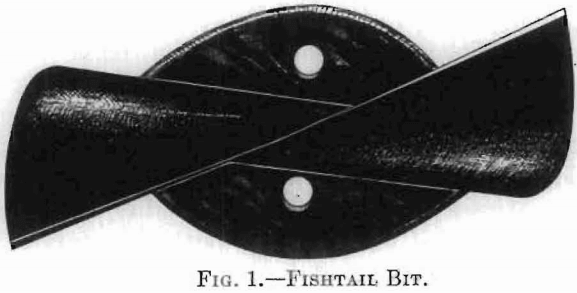
pipe are subjected, when drilling a hole from 4 to 18 in. in diameter, result often in twist-offs of the drill stem and costly fishing jobs. With the use of the heavier rigs and deeper drilling the need for a bit adapted to cutting rock became a crying necessity.
It was to meet this need that the cone bit, known as the Sharp & Hughes, was invented by me in 1908.

In brief, it consists of two or more detachable, cone-shaped cutters of hardened steel (see Fig. 2). These cutting cones revolve on bronzed bearings, lubricated with a special heavy viscous oil supplied by means of a small pipe carried inside the drill stem (see Fig. 3). The cutters, being detachable, may be removed and sharpened when dull.
The old style fishtail bit scraped its way through the rock encountered. With hard rock or sandstone it soon wore flat, lost all cutting power and had to be renewed. This necessitated the removal and replacement of the entire drill stem, with many (perhaps several thousand) feet of pipe, the work of many hours.
The principle of the cone bit is entirely different. The edges, or cone points of the bit, roll in a true circle like a cone bearing, and crumble or chip away the rock. The cone points, being of very hard steel, wear away slowly. Often they show but slight wear after drilling 50 ft. of rock, a few inches of which would completely dull the ordinary fishtail
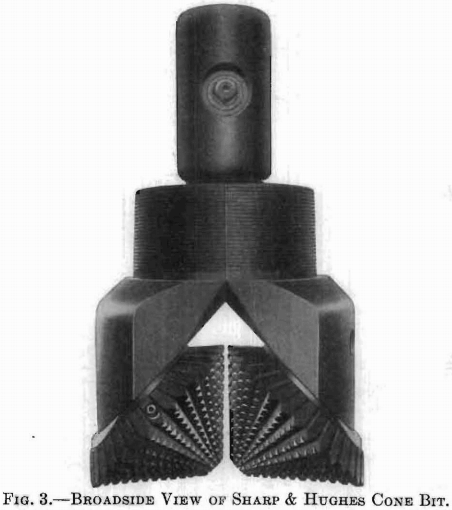
bit. The rolling motion allows the cutting edges on the cones to chip the rock, one edge after another.
Fig. 4 shows the bit, drill pipe, and lubricator in the hole, ready for drilling. The lubricator pipe, about 12 ft. long, is filled with oil, which is forced down into the bit by the pressure of the circulating water on the plunger. This figure shows also that the bottom of the drill hole as formed by the operation of the bit presents a perfect seat for a water-tight joint, preventing leakage after the casing has been set. When the cone bit is introduced in a hole to which previous use of the fishtail or diamond-pointed bit has given a V-shaped bottom, it must be advanced slowly and carefully for the first foot, so that it may change that shape to suit its own form of cut.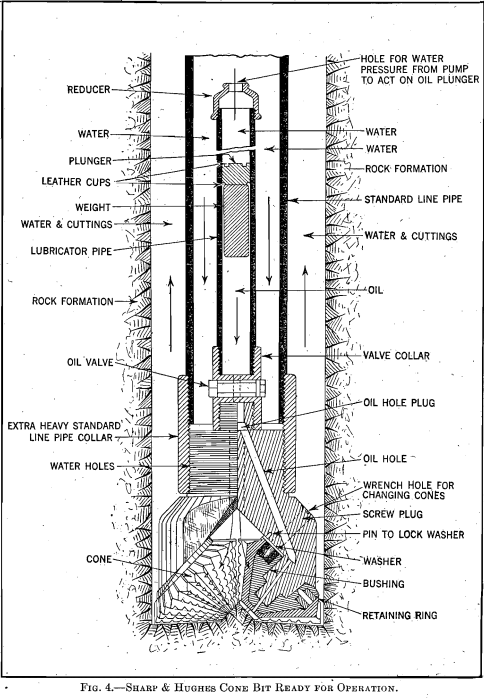
Fig. 5 shows the whole drilling-plant and apparatus of this system.
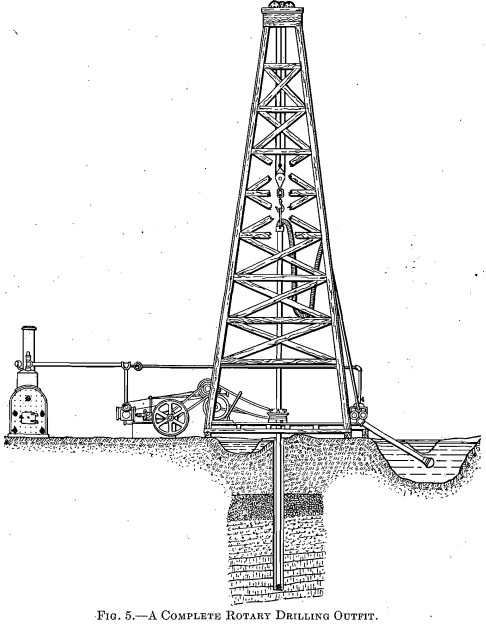
The proper adjustment of the weight upon the bit is the secret of good work with this drill. Experience has shown that the following weights give satisfactory results for the corresponding bits of standard sizes:
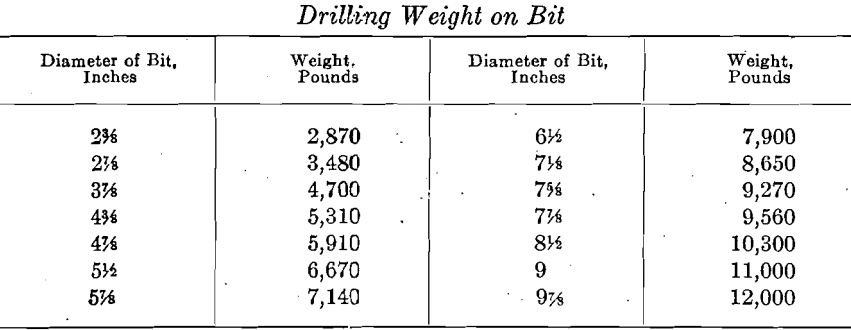
For bits larger than those in the table, as much weight as practicable may be employed with little or no risk of overloading the bearings in the bit. But within the limits of the table, the weights given are probably as great as prudence would permit. For extremely hard rock, the speed, not the weight, should be increased.
The following actual working tests show the performance of the cone bit in comparison with, the old fishtail:
The House No. 1 well of the Producers’ Oil Co., Humble, Texas, struck rock at 1,819 ft., after which the fishtail bit bored 38 ft. in 19 days —an average of 2 ft. a day. The cone bit was then substituted, and bored 72 ft. in 6 days, or 12 ft. a day.
The comparative costs were as follows:
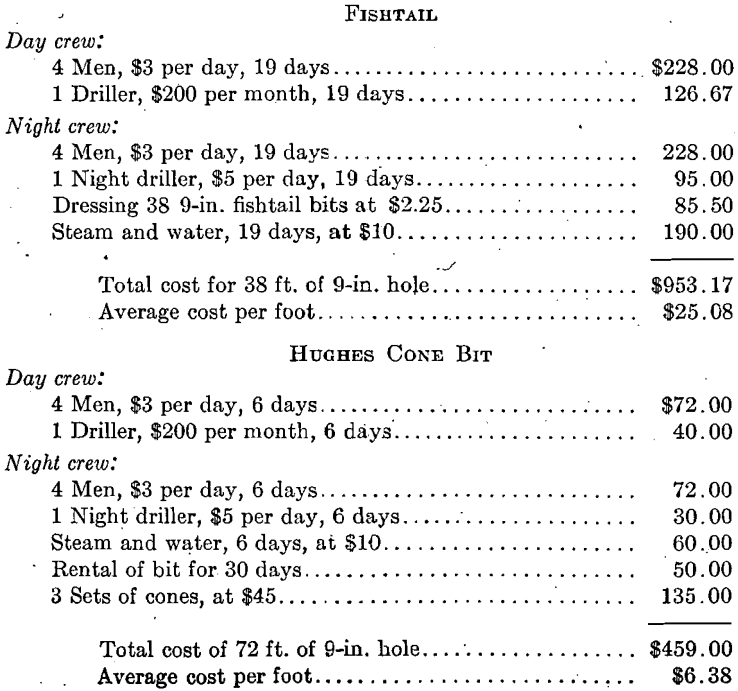
This comparison takes no account of the strain and wear upon machinery, the greater cost of superintendence per foot drilled, and the loss of time, under the old system.
While primarily designed for oil and water wells, this cone bit can be applied in drilling sump holes for mine pumps, in making air shafts, and in driving holes inclined at various angles from the vertical. Its use greatly enlarges the field of the rotary system, and the cone bit already is extensively used in California, Mexico, Trinidad, Roumania, Russia, Persia, Egypt, Japan, Borneo, and India, by presenting the great advantages of more rapid drilling through hard rock; of reaching greater depths than any other rotary apparatus can compass; of finishing a hole with smaller reduction of surface diameter than any other system permits; of the consequent requirement of fewer “strings” of casing; of less deterioration of drill pipe through strains and vibration, and of the saving of much time consumed in removing the drill pipe for sharpening or changing bits.
